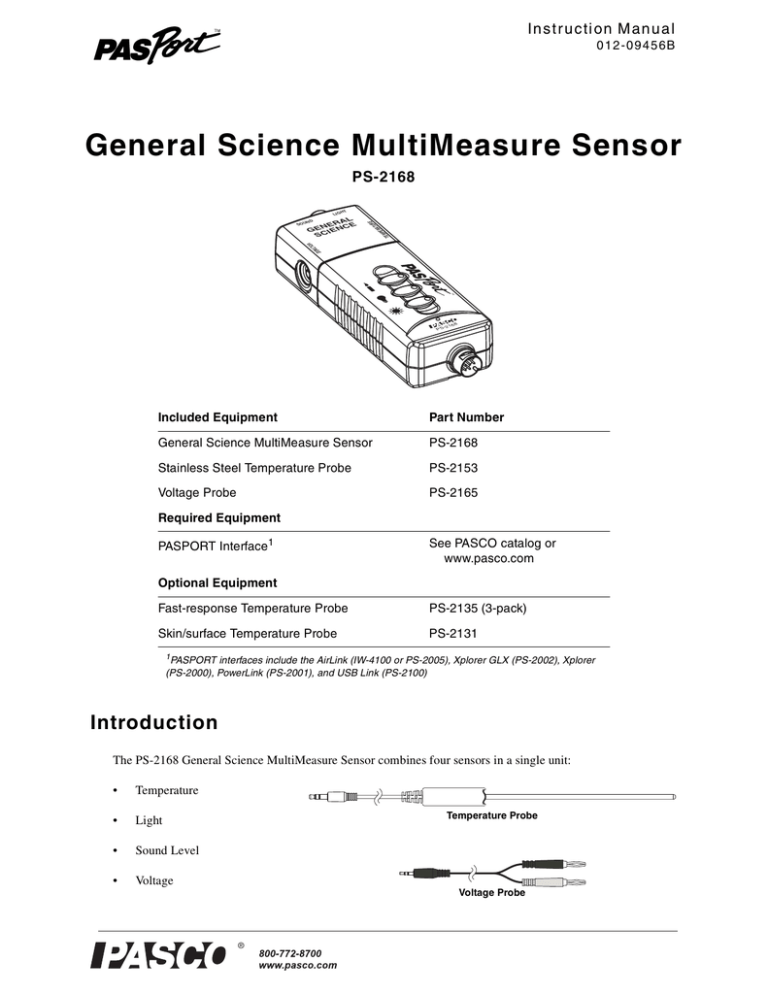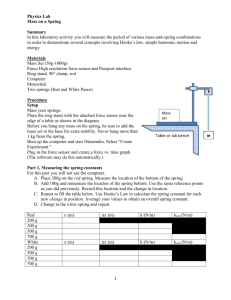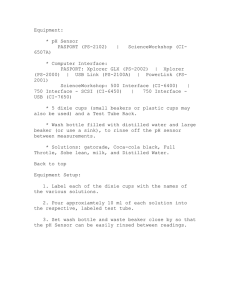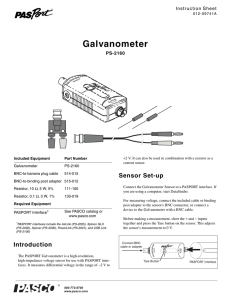General Science MultiMeasure Sensor If you are using the
advertisement

In s t r u c ti on M an u a l 0 1 2 - 0 9 4 5 6B General Science MultiMeasure Sensor PS-2168 HT TE MP ER U AT RE LIG L RA NE CE GE CIEN S ND SOU GE LTA VO ä 68 -21 PS Included Equipment Part Number General Science MultiMeasure Sensor PS-2168 Stainless Steel Temperature Probe PS-2153 Voltage Probe PS-2165 Required Equipment PASPORT Interface1 See PASCO catalog or www.pasco.com Optional Equipment Fast-response Temperature Probe PS-2135 (3-pack) Skin/surface Temperature Probe PS-2131 1 PASPORT interfaces include the AirLink (IW-4100 or PS-2005), Xplorer GLX (PS-2002), Xplorer (PS-2000), PowerLink (PS-2001), and USB Link (PS-2100) Introduction The PS-2168 General Science MultiMeasure Sensor combines four sensors in a single unit: • Temperature • Light • Sound Level • Voltage Temperature Probe Voltage Probe ® S e n s o r , I n t e r f a c e , a n d S o f tw a r e S e t u p SOUND Voltage LIGHT GENERAL SCIENCE VOLTAGE When connected to a PASPORT interface, the multi-sensor collects data at up to 200 samples per second from each component sensor. You can use just one component sensor at a time or any combination simultaneously. If you have a PASPORT interface that supports multiple sensors, or if you have more than one interface connected to your computer, you can use the General Science MultiMeasure Sensor in combination with other PASPORT sensors. SENSOR Connect the multi-sensor to your PASPORT interface as pictured (right). Connect the included temperature and voltage probes to the ports on the sides of the multi-sensor. (You can leave either of the probes disconnected if you do not plan to use it.) Temperature ä Sensor, Interface, and Software Setup TEMPERATURE G e n e r a l S c ie n c e M u lt i Me a s u r e Se n s o r PS-2168 PASPORT Interface Follow the instructions below to set up the sensor with DataStudio software (if you are using a computer) or the Xplorer GLX (if you are using it standalone without a computer). For detailed information about each of the multi-sensor sensor’s component sensors see below on this page and the next page. DataStudio Setup If you are using a computer, connect the PASPORT interface to the computer and start DataStudio. (Refer to the documentation that came with your PASPORT interface for instructions on connecting it to your computer.) In DataStudio, click the Start button to begin data collection; click the Stop button to stop data collection. The General Science MultiMeasure Sensor always collects sound-level, light, and voltage data, but collects temperature data only if a temperature probe is connected. The default sampling rate is 2 Hz. To change the sampling rate or hide measurements that you do not need, open the Experiment Setup Window by clicking the Setup button. For more instructions on using DataStudio, press F1 to open DataStudio’s on-line help. Click to Start Xplorer GLX Setup If you are using an Xplorer GLX in standalone mode, press to start data collection. The General Science MultiMeasure Sensor always collects sound-level, light, and voltage data, but collects temperature data only if a temperature probe is connected. The default sampling rate is 2 Hz. To change the sampling rate or hide measurements that you do not need, open the Sensors screen (from the Home screen, press F4 ). For more instructions on using the Xplorer GLX, refer to the GLX Users’ Guide. Temperature Use this component of the multi-sensor to measure the temperature of a fluid or object. The measurement can be displayed in units of °C, °F, or K. (In DataStudio, click the Setup button to change units.) You can use the included stainless steel probe or a different probe, such as the Fast-response Probe (PS-2135) or Skin/Surface Probe (PS-2131). PASCO physics apparatus containing an embedded 10 kΩ thermistor can also be connected to the multi-sensor. The multi-sensor automatically detects the 2 ® Model No. PS-2168 L ig h t presence of a temperature probe, and will only collect temperature data if a probe is connected. To measure temperature, connect the probe and start data collection. Immerse the tip of the probe in a fluid or place it in contact with an object. The included probe is suitable for temperatures between −35 °C and +135 °C. It can be used in both dry conditions and in liquids, such as water and other mild chemicals and solutions. Tip: Keep the connector of the probe and the body of the multi-sensor away from liquids. For better chemical resistance, use a Teflon® cover (CI-6549). The temperature measurement can be calibrated; however, for most applications calibration is not necessary. For instructions on calibrating in DataStudio, see Appendix A. For instructions on calibrating on the Xplorer GLX, refer to the Xplorer GLX Users’ Guide. Light The light component of the multi-sensor measures light intensity, or the power per unit area of light incident on the light-sensitive element. The element is located behind the black cylinder protruding from the multi-sensor. Though it measures light intensity, the sensor’s output is calibrated to indicate illuminance in units of lux. Range 100 lux 10000 lux Point the sensor in the direction of a light source and start data collection. The light sensor has three ranges, which you select using the three buttons on the multi-sensor. To select a range, push one of the buttons: for 0 lux to 100 lux, for 0 lux to 10000 lux, or for 0 to 150000 lux. Lights on the buttons indicate which range is selected. To determine which range is appropriate, look at the data (on a Graph display, for instance) while it is being collected; if the measurement appears to be “railed” at the top of the selected range (100 lux or 10000 lux), select the next higher range. You can push a button to change the range without stopping data collection. 150000 lux Light indicates selected range Tip: If you anticipate that the measured value will increase during your experiment, select a higher range. Tip: Fluorescent lights flicker at a high rate (100 Hz or 120 Hz), which causes aliasing, or the illusion of a lower-frequency periodic signal, in data collected at relatively low sampling rates. For this reason, it is recommended that the General Science MultiMeasure Sensor be used to measure light from incandescent bulbs and natural light sources. To measure high-frequency light sources, use the PS-2106 Light Sensor, with a maximum sampling rate of 1000 Hz. Sound Level Source The sound component sensor measures sound level on the dbA weighting scale. This weighting scale is designed to match the frequency response of the human ear and is commonly used to measure environmental sound levels. The table (right) shows some typical sound levels. Voltage Use the voltage component of the multi-sensor to measure electric potential difference between the terminals of a battery or power supply, or two points on a circuit. The voltage probe has two connectors: red and black. The sensor measures the voltage of the red connector in reference to the black connector. Its range is ±24 V. ® Sound Level (dBA) Rustling leaves 20 Library 40 Normal conversation 60 Noisy office 80 Subway train 100 Rock concert 120 3 G e n e r a l S c ie n c e M u lt i Me a s u r e Se n s o r Sp e c if ic a tio n s Specifications General Component Sensors Temperature, Light, Sound Level, Voltage Max. Sampling Rate 200 samples per second (for each component sensor) Default Sampling Rate 2 samples per second Temperature Range −35 °C to +135 °C Accuracy ±0.5 °C Resolution 0.01 °C or better Sensing Element 10 kΩ thermistor located in probe tip Light Output calibrated to indicate illuminance three user-selectable ranges: 100 lux, 10000 lux, 150 000 lux Spectral Response 320 nm to 1100 nm Sound Level Range 50 dbA to 100 dbA Accuracy ±4 dBA Resolution 0.1 dBA Repeatability 0.5 dBA Voltage 4 Range −24 V to + 24 V Accuracy ± 0.1 V Resolution ± 0.001 V Voltage Protection up to 240 V Input Resistance 1 MΩ ® Model No. PS-2168 S p e c if i c a t io n s Appendix A: DataStudio Temperature Calibration In DataStudio, click the Setup button to open the Experiment Setup window; in that window, click the Calibrate button to open the Calibrate Sensors dialog box. For a two-point calibration, you will need two “known standards,” or liquids that you know the temperature of, such as ice water and boiling water. 1. From the Sensor field, select General Science. 2. Ensure that “Calibrate all similar measurements simultaneously” is not selected. 3. From the Calibration Type menu, select 2 Point (Adjust Slope and Offset), if it is not already selected. 4. Place the probe in the first known standard. 5. Enter the known temperature of the standard in the Standard Value field for Point 1. 6. Observe the Present Sensor Measurement and wait until it has stabilized. 7. Click the Read From Sensor button for Point 1. 8. Place the probe in the second known standard. 9. Enter the known temperature of the standard in the Standard Value field for Point 2. 10. Observe the Present Sensor Measurement and wait until it has stabilized. 11. Click the Read From Sensor button for Point 2. 12. Click OK to accept the new calibration. Appendix B: EZ Screen If you are using the General Science MultiMeasure Sensor with a PASPORT interface connected to a computer, you can use EZ-Screen software instead of DataStudio. When the sensor is connected to the computer through the interface (if DataStudio is not running) a window automatically launches giving you the option of launching EZ-Screen. In EZ-Screen, click the green arrow button to start data collection. Click the General Science Sensor icon in the lower-right corner to cycle through sound-level, voltage, temperature, and light measurements. Click to start data collection Click to change measurements EZ-Screen ® 5 G e n e r a l S c ie n c e M u lt i Me a s u r e Se n s o r T e c h n ic a l S u p p o r t Technical Support For assistance with any PASCO product, contact PASCO at: Address: PASCO scientific 10101 Foothills Blvd. Roseville, CA 95747-7100 Phone: 916-786-3800 (worldwide) 800-772-8700 (U.S.) Fax: (916) 786-3292 Web: www.pasco.com Email: support@pasco.com Limited Warranty For a description of the product warranty, see the PASCO catalog. Copyright The PASCO scientific 012-09456B General Science MultiMeasure Sensor Instruction Manual is copyrighted with all rights reserved. Permission is granted to non-profit educational institutions for reproduction of any part of this manual, providing the reproductions are used only in their laboratories and classrooms, and are not sold for profit. Reproduction under any other circumstances, without the written consent of PASCO scientific, is prohibited. Trademarks PASCO, PASCO scientific, DataStudio, MultiMeasure Sensors, PASPORT, and ScienceWorkshop are trademarks or registered trademarks of PASCO scientific, in the United States and/or in other countries. All other brands, products, or service names are or may be trademarks or service marks of, and are used to identify, products or services of, their respective owners. For more information visit www.pasco.com/legal. Teflon is a registered trademark of DuPont. 6 ®





